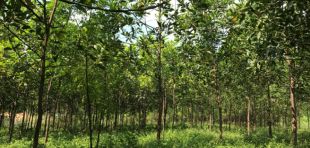Energy crops a viable option on post-mining sites

The cultivation of energy crops on post-mining sites in Viet Nam not only reduces CO2 emissions, but also helps recultivate unused land. In addition, it has a positive impact on biodiversity at these sites and on the living conditions of local farmers.
On 11 October, the results of a three-year pilot study on planting energy crops on land formerly used for mining in Viet Nam were presented at a project workshop in Hanoi. Since 2015, the International Climate Initiative project Cultivation of Energy Plants on Set-Aside Mining Sites in Viet Nam (Climate Protection through Energy Plants – CPEP) has been testing which bioenergy crop systems are agriculturally feasible and economically viable on three pilot sites in northern and southern Viet Nam. Since the close of the project, the results have been presented along with a detailed report about the experience gained in cultivating bioenergy crops.
Some 50 experts, including many scientists from the fields of biomass cultivation, soil protection and renewable energy, joined staff from the Ministry of Agriculture and Rural Development, the Ministry of Natural Resources and Environment and the Ministry of Industry and Trade, which is responsible for renewable energy, to discuss lessons learned and utilise the project outcomes to further develop the bioenergy sector in Viet Nam.

In his opening address, the Director of the Department for Administration of the Vietnam Environment Administration (VEA), Ho Kiem Trung, welcomed the project, which he described as an effective part of the country’s Green Growth Strategy and as a contribution to implementing the Paris Agreement on climate change, under which Viet Nam has undertaken to reduce greenhouse gas emissions by 8 per cent by 2030. He also pointed out that the project has made tangible progress on driving forward efforts to recultivate abandoned mining sites. In particular, the mining companies involved in the project have paved the way for all 4,000 mining sites in Viet Nam. Andreas Bieber from the German Federal Ministry for the Environment, Nature Conservation and Nuclear Safety (BMU) expressed similar satisfaction, and stressed that the success of the project has generated a wealth of valuable experience in the accelerated, climate-appropriate cultivation of bioenergy crops in Viet Nam.

As well as testing a variety of cropping systems for energy plants, a numbers of processing scenarios for the different sites were examined along with their climate impacts, some of which were calculated. The cultivation of cassava (manioc) produced excellent results. In a report produced by Hanoi University of Science and Technology, evidence was provided that, in comparison to the use of conventional petrol, fuel produced using bioethanol extracted from cassava grown on post-mining sites can cut CO2 emissions by 49.3 per cent. This means that the potential CO2 savings offered by bioethanol made from cassava grown on post-mining sites are even higher than those offered by conventionally produced cassava-based bioethanol in Viet Nam, as the adverse climate-related impacts of changing land use are considerably lower on post-mining sites.
 A respectable 20 per cent reduction in CO2 emissions was achieved by growing certain grass varieties for biogas production on abandoned mining sites based on the assumption that traditional methods of heating and cooking (gas or coal-fired ovens) are otherwise retained. Promising processing scenarios were identified for all sites, including use in biomass power stations and the production of bioethanol. Thus, the cultivation of cassava for bioethanol production would, in fact, be economically viable at post-mining sites, assuming that a bioethanol plant exists within a radius of about 80-100 kilometres. The use of small-scale biogas plants could offer another viable option for processing the energy crops.
A respectable 20 per cent reduction in CO2 emissions was achieved by growing certain grass varieties for biogas production on abandoned mining sites based on the assumption that traditional methods of heating and cooking (gas or coal-fired ovens) are otherwise retained. Promising processing scenarios were identified for all sites, including use in biomass power stations and the production of bioethanol. Thus, the cultivation of cassava for bioethanol production would, in fact, be economically viable at post-mining sites, assuming that a bioethanol plant exists within a radius of about 80-100 kilometres. The use of small-scale biogas plants could offer another viable option for processing the energy crops.
In addition to use as energy crops, a number of other possible uses were explored during the project. At the post-mining site in Nui Phao, for instance, energy plants were cultivated not only on the pilot site but also on other mining sites belonging to the same company, helping reduce erosion and largely prevent landslides caused by heavy rainfall. The Vietnam Environment Administration (VEA), the body responsible for recultivating post-mining sites, is even considering including the cultivation of bioenergy crops in the list of possible recultivation measures in Viet Nam. The CPEP project has proved that the use of abandoned and hitherto uncultivated sites to cultivate energy crops and produce bioethanol can make an effective and economically viable contribution to climate change mitigation.
The link has been copied to the clipboard
Contact
IKI Office
Zukunft – Umwelt – Gesellschaft (ZUG) gGmbH
Stresemannstraße 69-71
10963 Berlin





